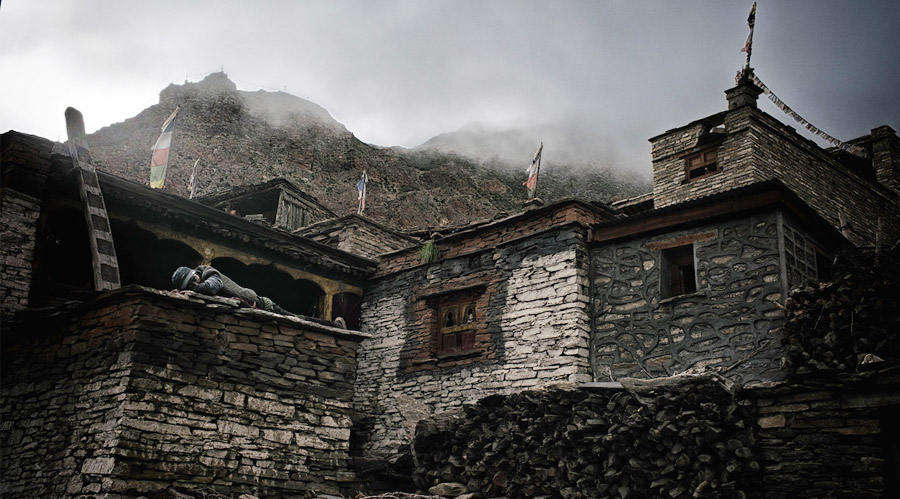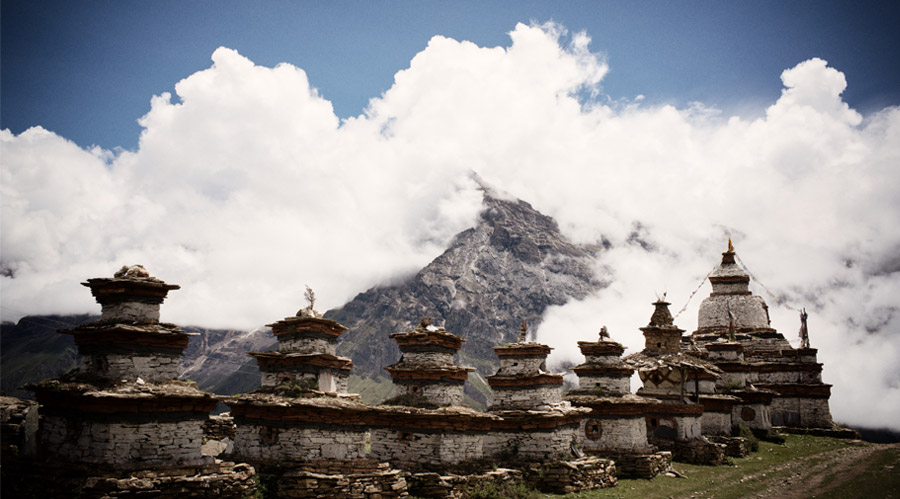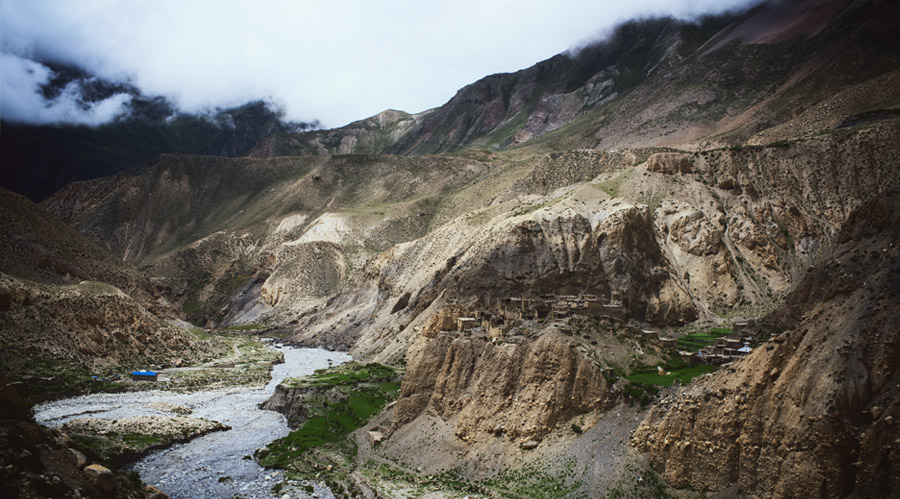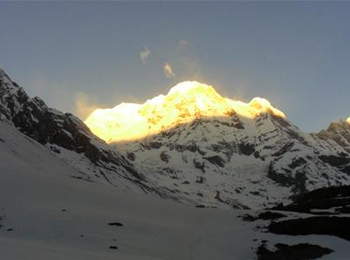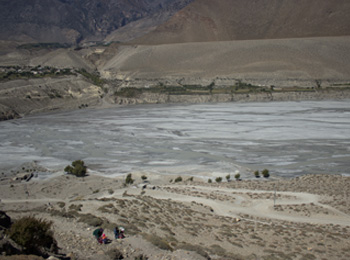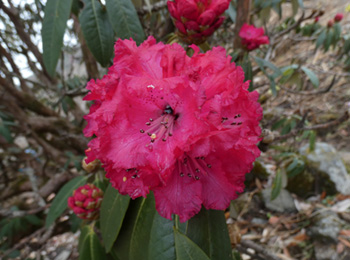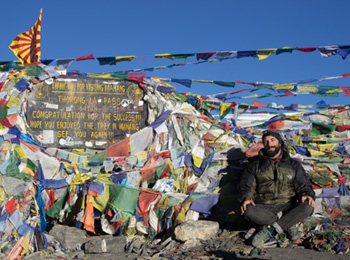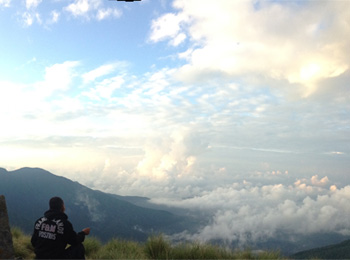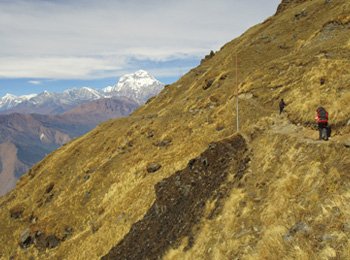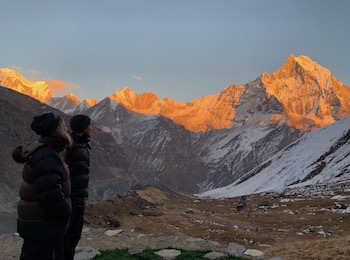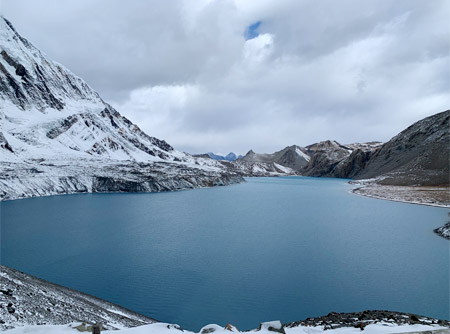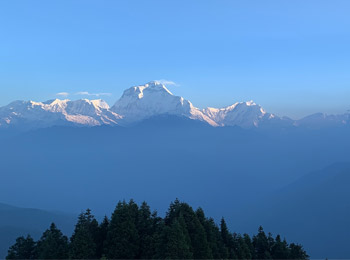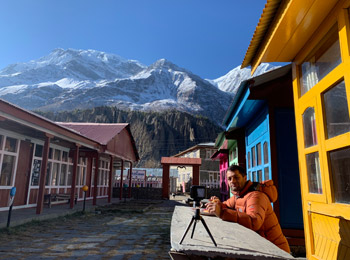- +977 9851074270
- info@mountainramadventures.com
Trip Highlights
- A fantastic alternative to famous crowded trekking routes in the Annapurna region
- Off-the-beaten-trail, untouched trekking route, and unspoiled surrounding
- A very challenging and advanced trek in Nepal that explores the hidden Nar Phu Valley
- Ideal for trekkers with past trekking experience and strong physical fitness
- The trail gradually ascends through lush forests to narrow gorges, moraines, meadows, and glacial valleys
- Overnight stay in beautiful villages where you will get to learn about the locals and their rich cultural heritage
- Explore ancient monasteries along the trail and hike to Himlung Himal Base Camp
- Test your limits and push yourself while crossing the Kang La pass (over 5,000 meters)
- Witness incredible mountain panoramas and a wide range of landscapes
Detail About Nar Phu Valley Trek
Just off the very famous Annapurna circuit trail lies a hidden valley untouched and untrodden by adventure lovers. It is called Nar Phu Valley. The valley is tucked between the Annapurna and Manaslu regions, two known trekking destinations in Nepal. The Nar Phu Valley trek is an adventurous and offbeat 14-day venture that will let you enjoy sensational mountain views and the serenity of the Himalayas.
The Nar Phu Valley trek was opened in 2003. As the trail is located close to the Tibetan border, the entire Nar Phu Valley is made a restricted area. So, trekkers have to get special permits and follow a different set of rules to travel here. You can do this trek in spring and autumn. Winter trekking is also possible with better preparation and trail conditions. Nar Phu Valley trek 14 days is for travelers with previous trekking experience.
The journey is very adventurous. You will be traveling in the remote parts of the western Himalayas in Nepal that are not visited by many trekkers. The trekking route is not crowded and gets isolated in many sections. Nar Phu Valley trek is perfect for anyone looking for a true Himalayan challenge to push themselves. The trek crosses a high mountain pass over 5,000 meters (16,404 ft) and involves walking by moraines and gorges.
Apart from the adventure, the Nar Phu Valley trek also lets you immerse in the rich cultural heritage of the locals. The trekking route is dotted with stupas, monasteries, chortens, mani walls, and prayer flags. The locals are friendly and kind. Their hospitality will enhance your overall trek experience. There are rest days in our Nar Phu Valley trek itinerary that will let you enjoy more time with locals in the Phu village.
On this trek, you will witness breathtaking views of mountains like Annapurna II (7,937 m/ 26,040 ft), Hiunchuli Himal (6,441 m/21,132 ft), Dhaulagiri (8,167 m/26,795 ft), Himlung Himal (7,126 m/23,379 ft), Pisang Peak (6,091 m/19,984 ft), Tilicho Peak (7,134 m/23,406 ft), Manaslu (8,163 m/ 26,781 ft), and many others. The landscapes change from lush green hills and dense forests to barren hills, landslide-prone areas, and rocky paths.
Today, the Nar Phu Valley trek in Nepal stands as the best off-the-beaten trekking package. Blue sheep, barley and buckwheat fields, yaks, meadows, and the simple lifestyle of the locals are the added charm of the Nar Phu Valley trek route. You will hike to the rarely visited Himlung Himal Base Camp and also come across the stunning Pangri Glacier. Join us on this lifetime Nar Phu Valley trek 2025/2026 and get to witness some of the most gorgeous scenery on Earth.
Nar Phu Valley location
The Nar Phu Valley is a remote and relatively unexplored region located in the Annapurna Conservation Area of Nepal. It is a hidden gem nestled between the more popular trekking routes of Annapurna and Manaslu, offering a unique and off-the-beaten-path experience for trekkers and adventurers.
Proximity to major cities and areas:
- Kathmandu: Nar Phu Valley is approximately 200 kilometers northwest of Kathmandu, Nepal's capital.
- Pokhara: It is about 100 kilometers north of Pokhara, a popular tourist destination and the second-largest city in Nepal.
- Manang: The district headquarters, Manang, is the nearest major town to Nar Phu Valley and serves as the starting point for many treks in the Annapurna region.
Altitude:
- The Nar Phu Valley sits at a relatively high altitude. The villages in the valley are located between 3,000 meters (9,800 feet) and 4,200 meters (13,780 feet) above sea level.
- Kang La pass is the highest point on the Nar Phu Valley trek 14 days. It is at 5,320 meters (17,460 ft).
The locals and history of Nar Phu Valley
The history of the Nar Phu Valley is closely intertwined with the cultural and religious practices of its indigenous inhabitants, the Nar and Phu communities. These communities are of Tibetan origin and have preserved their distinct way of life and beliefs for centuries.
The origins of the Nar and Phu communities in the valley can be traced back to Tibetan migration across the Himalayas. These communities settled in the remote and rugged region, creating a distinct cultural identity that is heavily influenced by Tibetan culture and Buddhism.
Due to its remote location and challenging terrain, the Nar Phu Valley remained isolated from the rest of Nepal for much of its history. This isolation played a significant role in preserving the traditional way of life and cultural practices of the Nar and Phu communities.
In recent years, the Nar Phu Valley has seen increased outside influence due to the growth of trekking tourism in the region. While this has brought economic opportunities and exposure to the communities, it has also introduced changes to their way of life and cultural practices. But the locals and their lifestyle are still very well connected to their roots, and you will get to enjoy a raw, untampered mountain life.
Nar Phu Valley trek length and terrain
During the Nar Phu Valley trek, you will traverse through rugged and pristine landscapes. Typically, the Nar Phu Valley trek spans approximately 14 to 18 days, depending on various factors such as the chosen itinerary, acclimatization days, and trekking pace. Our Nar Phu Valley trek itinerary is 14 days long with ample acclimatization days.
The Nar Phu Valley trek is renowned for its diverse and challenging terrain. The trek begins with relatively gentle trails through lush forests and beautiful villages. As you ascend, the trails become steeper and more rugged. The itinerary involves crossing high mountain passes called the Kang La pass (5,322 meters).
Along the trail, you will cross several rivers and streams and come across many gorgeous waterfalls. The trail takes you through diverse landscapes, from lush forests of pine and rhododendrons to barren, high-altitude terrains with minimal vegetation. You will be exploring rocky gorges, moraines, glacial valleys, pristine meadows, and breathtaking views of towering peaks.
Nar Phu Valley Trek Difficulty
Trekking to Nar Phu Valley is very challenging. The steep terrain, remote location, and limited facilities along the trail make it one of the most difficult treks in Nepal. Previous trekking experience is usually recommended for this trek as it will help you understand the difficulties and will not let you get overwhelmed.
Daily trekking hours are 5 to 6, however while crossing Kang La pass, expect 8 hours of walking. For new trekkers, the Nar Phu Valley trek can become quite strenuous. Therefore, your fitness matters a lot for this trek. You do not have to be athletic, but strong fitness and mental resilience are needed.
You can always train your body for the trek. Daily exercise, regular, long walking, and cardio will help you get fit for the trek. Likewise, you have to understand the limitations of the Himalayas and set your expectations as per that. Packy wisely, and do not hesitate to ask your queries regarding the trek with us.
Transportation on the trek
The Nar Phu Valley trek includes two long drives on each side (at the start and end of the trek). From Kathmandu, you will first drive to Besisahar, and the next day, take a local jeep to Dharapni, where the trek starts. Likewise, the trek ends in Ngawal village. From here, you will drive to Besisahar and then to Kathmandu the following day.
All these transportation costs are included in our package cost, so you do not have to pay extra. There is no domestic flight alternative, however we may arrange a helicopter flight if you wish to escape these long drives on either side. One alternative is flying commercially from Kathmandu to Pokhara and taking a 2-3 hour ride to Besisahar.
Nar Phu Valley trek preparation
The Nar Phu Valley trek presents a challenging level of difficulty. To ensure an enjoyable experience, you have to prepare yourself physically and mentally. Engaging in a fitness regimen that includes cardiovascular exercises, strength training, and flexibility work will help you a lot. You can go hiking on uneven terrains and walk long hours regularly. Anything that will help you build your stamina and strength is recommended.
Likewise, prepare mentally for the physical challenges and the remote nature of the trek. Understand that you will disconnect with technology on this trek. Embrace nature and its wilderness. You have to make a lot of adjustments to your meals and accommodations. Therefore, a positive attitude and mental resilience are equally needed for this trek to keep you calm and collected throughout the trek.
Best Nar Phu Valley trek package for 2025/2026 with native guides and porters
With the expertise of our team and massive network, we assure you of a safe Nar Phu Valley trekking experience in Nepal. Our Nar Phu Valley trek package includes all the necessities and allows you to modify the trip as per your budget and requirements. Nothing is impossible with us in Nepal. This is the best Nar Phu Valley trek in Nepal. And we have opened our Nar Phu Valley trek 2025/2026 booking for all avid travelers.
Do note that you cannot do the Nar Phu Valley trek without a guide, however we can organize a private trek for you and only one other trekker in the group. It will let you have a solo trekking kind of experience under the supervision of our professional mountain guide, who will ensure your safety. Likewise, our Nar Phu Valley trek cost is the finest in the market with special discounts on groups of 6 or more trekkers.
Unlock extraordinary adventures with us- benefits of choosing Mountain Ram Adventures for Your Nar Phu Valley trek in Nepal
With 20+ years of experience organizing treks in Nepal, our team possesses in-depth knowledge of the Nar Phu Valley and its hidden gems. We understand the terrain, weather, and cultural practices, ensuring a well-informed and smooth trekking experience.
No two adventurers are the same, and neither should their journeys be. We offer customizable itineraries that cater to your preferences and fitness level. Whether you're an experienced trekker seeking a challenge or a novice wanting a more leisurely pace, we have the perfect plan for you.
Our knowledgeable guides are your companions, storytellers, and problem-solvers throughout the trek. From the moment you reach out to us until you return home, expect personalized attention and exceptional service. Our team assists you with pre-trip preparations, helps you secure necessary permits, and provides timely updates on weather and trail conditions.
By choosing Mountain Ram Adventures, you align yourself with a company that advocates responsible and clean travel. Join us in practicing eco-friendly habits and minimizing our impact on the environment while maximizing the positive influence on local communities.
Alternate trekking packages in Nepal
We have many leisure and adventure holiday packages in Nepal for all ages. From treks to tours, jungle safaris, and climbing expeditions, we specialize in many adventure activities in Nepal.
These are some of our challenging trekking packages like the Nar Phu Valley trek- Upper Mustang trek, Everest Three High Passes trek, Upper Dolpo Trek, Manaslu Tsum Valley trek, Annapurna Circuit with Tilicho Lake trek, and Langtang Circuit trek.
You can customize any trekking or tour packages with us in Nepal, including the Nar Phu Valley short trek. For more information, contact us at info@mountainramadventures.com, or you can also call/text this number- +977 9851074270.
Likewise, these are some of our famous tour packages in Nepal- Kathmandu Pokhara tour, Cultural Tour in Nepal, Everest Base Camp Helicopter tour, and Culture and Jungle Safari Tour in Nepal.
Let's be responsible for our waste- clean travel
Little changes in our choices can make our trek in the Nar Phu Valley an eco-friendly and sustainable trip. As you prepare to embark on a trekking adventure in Nepal, we encourage you to join us in practicing responsible and clean travel. Here's how you can contribute:
- Choose a refillable water bottle to minimize single-use plastic waste.
- Pack biodegradable toiletries and consider reusable cutlery and food containers to reduce disposable waste.
- Avoid single-use plastics like plastic bags and straws.
- Leave no trace behind. Properly dispose of all waste, including food wrappers, tissues, and other packaging.
- In areas with waste disposal facilities, use designated waste bins for different types of waste – recyclables, non-recyclables, and organic waste.
- Lead by example and share your clean travel practices with fellow travelers.
Your feedback drives our excellence- help us enhance our services
At Mountain Ram Adventures, we are committed to continuously improving our services to provide you with the best possible travel experiences in Nepal. Your feedback allows us to identify areas where we excel and areas where improvements are needed. This ensures that every aspect of your journey aligns with our commitment to excellence.
Feel free to reach out to our customer service team with your feedback, suggestions, or concerns. We are here to listen and take immediate action to address any issues. You can leave reviews on our website, social media platforms, or travel review websites.
Trip Itinerary Expand All
- 1,400 m/4,600 ft
- Hotel
On your arrival day in Kathmandu, our team will pick you up from the Tribhuvan International Airport. We use a private vehicle during our airport pickup and drop-off. So you will have a comfortable ride to the hotel. We will book you a nice three-star hotel with all the amenities and a spacious room for your stay in Kathmandu. The remaining day is free for you to rest and explore your surroundings.
- Breakfast only
- Hotel
This is the day we prepare your special permit for Nar Phu Valley so we need this day. You can go shopphing and buy trekkign equipments (our staffs can help you with it). In the late afternoon, we will meet you in our office for the trek preparation. Our mountain guide will introduce himself and brief you on the journey. We will then proceed with packing our duffel bags and do any last-minute shopping if needed.
- Breakfast, lunch, and dinner
- 760 m/2,93 ft
- Lodge
The starting point of our Nar Phu valley trek is located quite far from Kathmandu. On this day, we will take a long ride to Besisahar. As we leave the city, the lush green hills come into perspective. The road follows winding hills and goes along the Trishuli and Marsyangdi rivers. The drive offers views of hills, terraces, and narrow waterfalls.
Till Dumre, the road is well made, so there will be no discomfort. From here onwards, the roads get bumpy till Besisahar. As we get close to Besisahar, we can see views of snow-capped mountains like Lamjung Himal and Manaslu. Besisahar is a beautiful small town with welcoming locals. Spend the evening exploring the local market.
- 6-7 hours
- Breakfast, lunch & dinner
- 1,860 m/ 6,200 ft
- Teahouse
Today, we will drive from Besisahar to Dharapani. The ride will be quite thrilling and bumpy. We will be following uneven hillsides and pass by small villages like Bhulbhule (840 m), Bahundanda (1,310 m), Jagat (1,300 m), and Chamje (1,430 m). On the way, we get to see superb landscapes along with views of Annapurna II, Lamjung Himal, etc.
- 6 hours
- Breakfast, lunch & dinner
- 2,610 m/8,563 ft
- Teahouse
Continuing trekking from Dharapani, we will cross a bridge and trek through lush forests of fir, maple, and oak. The trail passes by Bagarchhap at 2,160 meters and Danakyu at 2,190 meters. Bagarchhap is a lovely little settlement with a Tibetan monastery & offers stunning views of mountains.
After Danakyu, we will ascend via Timang (2,750 m) and Thanchowk (2,400 m) to Koto (2,600 m). On the way, we get to see excellent views of Mt. Manaslu, Lamjung Himal, Annapurna II, and Hiunchuli. Koto is mainly inhabited by Gurungs.
- 7-8 hours
- Breakfast, lunch & dinner
- 3,560 m/11,680 ft
- Teahouse
Koto to Meta is a long trek. The trail ascends along the Naar Khol to a Campsite at 2,740 meters. From here onwards, we will ascend to Naar Phu Khola Campsite at 2,980 meters. Further, we will cross two bridges on the Naar Khola and Seti Khola and steeply ascend, passing by Chhongche Caves. The trail keeps climbing, crossing three more suspension bridges to Meta via Singenge Dharmasala at 3,230 meters.
- 7-8 hours
- Breakfast, lunch & dinner
- 4,250 m/13,944 ft
- Teahouse
The trail ascends to Nar Phedi, where we will visit an ancient monastery called Sartek Thrangu Choepel Ling Gompa and a few other gompas. Following a steep, rocky path, we will keep climbing towards Chyakhu. On the way, we will also cross a bridge over Junam Khola. From Chyakhu, the trail ascends to Kyang at 3,887 meters and continues crossing three more suspension bridges on Phu Khola to Phu village.
The trail includes rugged sections and passes by Phu Rock Pillar, which is the entrance gate of Phu valley. Today, we will see breathtaking views of Pisang Peak, Annapurna II, Kangaru Himal, Himlung Himal, etc. Phu village is one of our major attractions of this trek, located in the remotest part of the Annapurna region.
- Breakfast, lunch & dinner
- Teahouse
Phu village is famous for its blue sheep, the rich cultural heritage of the locals, and their unique lifestyle. Trekking here is like traveling back in time, where nothing has changed much. We will spend an acclimatization day in this village. This one extra day here will not only allow us to rest and recover but also explore the village and its surroundings.
Tashi Lhakhang Monastery is a significant religious point in the Nar Phu valley. The view of Himlung Himal is also splendid, along with many other Himalayan ranges. For the hike, we have the option to walk to Himlung Himal Base Camp, which is visited by very few trekkers around the world. This is an isolated area and offers a stunning view of Pangri Glacier.
- 6 hours
- Breakfast, lunch & dinner
- 3,550 m/11,647 ft
- Teahouse
On this day, we will trek back from Phu Gaon to Nar Phedi. We will retrace the trail back. The landscapes and mountain views are equally rewarding, like the climbing period. We will cross multiple suspension bridges and small settlements on the way. There are many gompas in Nar Phedi. We will spend the late afternoon/early evening hours visiting these religious places.
- 3-4 hours
- Breakfast, lunch & dinner
- 4,150 m/13,615 ft
- Teahouse
From Nar Phedi to Nar Gaon is a short distance, so we will get plenty of time to enjoy the walk today and rest. The trail ascends to the first entrance gate of Nar valley and continues towards the second entrance gate of the Nar valley. We will trek past mani walls and stupas on the way, enjoying wonderful mountain views of Pisang Peak, Chulu Peaks, Annapurna II, etc.
As we will have a lot of free time in Nar village, we can explore the village and the old monasteries here. As we will cross a high mountain pass the following day, it is necessary that we rest a lot. Our time with locals here will be quite memorable. We will see them doing their daily chores and sharing their myths and tales with us.
- 7-8 hours
- Breakfast, lunch & dinner
- 5,322 m/17,460 ft
- Teahouse
We will leave Nar Gaon early in the morning after a big delicious breakfast. The trail gradually ascends and joins a steep moraine route that leads to Kangla Phedi (Jhombu Kharka) at 4,620 meters. From here, the trail ascends and crosses a metal bridge. We will then continue walking to Kang La pass top, following a steep rugged path.
From the top of the pass, the mountain views of Tilicho Peak, Gangapurna, Annapurna II, etc, are spectacular. From the top of the pass, the trail descends along grassy slopes and continues via a moraine. Further, we will trek through more grassy moraine and come across the magnificent Chulus Waterfall. The trail then steeply descends to Ngawal, where we will spend the night.
*Note: If you wish you can continue the trek to Annapurna Circuit from Ngwal.
- 8 hours
- Breakfast, lunch & dinner
- 760 m/2,93 ft
- Lodge
Our trekking part has ended. Now, it is time to travel back to Kathmandu. On this day, we will take a long eight-hour uneven ride to Besisahar. Following rugged hillsides, enjoying breathtaking mountain panoramas and diverse landscapes, we will trek past small villages like Upper Pisang, Chame, Dharapani, Chamje, Syange, and Nagdi.
- 6-7 hours
- Breakfast, lunch, and farewell dinner
- 1,400 m/4,600 ft
- Hotel
We will take another early morning ride in a comfortable tourist standard vehicle from Besisahar to Kathmandu today. The first 2-3 hours of the ride will be a bit bumpy, and after that, we will follow a well-made scenic highway to Kathmandu. The guide will drop you at the hotel once you reach the city. The remaining day is free in Kathmandu. Take a rest, unpack, and window shop in Thamel. In the late evening, we will gather in a nice restaurant to have a delicious dinner.
- Breakfast only
Our airport representatives will be at your hotel lobby as per your flight departure time. We hope you had a great time trekking with us, Mountain Ram Adventures, in the Himalayas of Nepal. Do leave your feedback without any hesitation. We wish you a smooth flight back home and look forward to traveling with you again in Nepal.
An elevated point of 5416m. You will be mountain climbing in the main on well established trails. Come and join a Great adventure trip.
Cost Includes
- Pick up and drop from and to Airport.
- 3 nights hotel in Kathmandu on B/B plan twin sharing. (Note: if solo, we will provide single private room in Kathmandu)
- All permits and paper works.
- All land transportation by bus / van / car.
- One Guide (experienced and registered, inc. insurance, salary and all food and accommodation)
- Accommodation in tea houses/lodges Twin sharing.
- 3 Meals a day: breakfast, lunch, dinner during the trek. (Anything from the menu)
- Fresh fruits every evening (Only if you hire a porter)
- Farewell dinner in Kathmandu after the trek.
- All taxes and Company service charge.
Cost Excludes
- Bar and beverage bills, bottled water, tea, coffee, desserts, personal expenses, personal cloths
- Personal insurance for health and evacuation and Tipping and Food in Kathmandu
- Per Porter 290 USD (20 kg weight limit)
Frequently Asked Questions Expand All
Nar Phu Valley trek can become very challenging for beginner trekkers. It is an offbeat trek in one of the remotest parts of the Annapurna region and also crosses a high mountain pass. If you are a beginner trekker, we recommend treks like Langtang Valley, Annapurna base camp, Mardi Himal, etc. These treks are equally adventurous and rewarding and perfect for beginner trekkers.
Nar Phu Valley trek cost starts at USD 1,100 per person and can go up to USD 2,200 per person. Trekking in a group with us will let you enjoy special discounts. Moreover, we also offer discounts from time to time to our guests. You can customize the Nar Phu Valley trek package as per your requirements and budget as well. We, Mountain Ram Adventures, offer the best Nar Phu Valley trek cost in the market with top-notch service.
Our Nar Phu Valley trek itinerary is 14 days long. You can extend the trek or shorten the itinerary as per your need. During the trek, you will walk approximately 6 hours a day. You will start the trek from Dharapani at 1,860 meters (6,200 ft) and ascend to Kang La Pass at 5,320 meters (17,460 ft) before returning to Kathmandu.
No, you do not require a TIMS Card for the Nar Phu Valley trek because it is a restricted area. You will need to get special permits from the government of Nepal to do this trek, along with an Annapurna Conservation Area Project permit.
Yes, you need a guide for the Nar Phu Valley trek. Foreigners are not allowed to do solo treks in the Nar Phu Valley as it is a restricted area in the Himalayas. Along with a licensed Nepali guide, you must have to trek with at least a group of two trekkers, and the trek must be organized by a registered local trekking company.
Yes, the Nar Phu Valley trek is safe. Moreover, trekking with our native guides who are certified in various outdoor essentials like survival, rock climbing, first aid, etc, we assure you a safe trekking. You will be guided by a team of experts who know the region and trail inside-out, making the journey worry-free.
No, you cannot do the Nar Phu Valley trek solo. Foreigners have to trek in a group of at least two trekkers, and it does not include your guide. If you are a solo trekker, you can join our fixed departure groups and trek with other fellow travelers from around the globe.
The Nar Phu Valley trek is strenuous. It means this trek is only recommended to those who have previous trekking experience and have strong fitness. Your mental and physical resilience is very important for this trek. The trekking route is rugged, steep, and difficult, with many long ascents and descents.
The best seasons to do Nar Phu Valley trekking are spring (March to May) and autumn (September to November). Spring and autumn seasons offer stable weather and a pleasant climate, which makes the journey manageable. Trekking in other seasons, like summer/monsoon (June to August) and winter (December to February), is further challenging because of weather issues and trail blockages.
Yes, you have to carry a sleeping bag with you on this trek. It will provide you with an extra layer of comfort and warmth at the upper part of the trail, which gets chilly in the mornings and nights.
To book the Nar Phu Valley trek with us, click on the booking button on our package page. You will be asked for your basic information and 20% advance payment. After we receive the details and the money, our team will send you a trip confirmation letter and get in touch with you.
We will help you get ready for the trek. You have to provide us with the remaining package cost and travel insurance documents before the trek starts. Failure to do so will cancel the trip, and you will not get any refund.
Useful Information
Itinerary Disclaimer
If you want to make any changes to our Nar Phu Valley trek itinerary, inform us while confirming the trip. The change in the itinerary may increase or decrease the package cost. We will stick to our confirmed itinerary unless circumstances ask for a modification.
Likewise, trekking in the Himalayas comes with uncertainties like unpredictable weather, road blockages, altitude sickness, etc. There can be unseen political disturbances that may affect the track course. Even though things like this rarely happen, you have to understand the threats.
In events like these, the trek leader will make a wise decision that will benefit all the trekkers in the group. He will inform you about ongoing occurrences and decide in the best interest of the group.
Airport Pickup and Drop
At the start and the end of the trek with us, our representatives will take care of your airport pickup and dropoff from/to Tribhuvan International Airport in Kathmandu. It is a complimentary service in our trek package. We use private vehicles and make sure you have a hassle-free and comfortable commute.
*Note: If you want further transportation assistance during your time in Nepal, let us know. We will arrange the best vehicle for you as per your requirements. Additional costs incur.
Safety and Security
Nar Phu Valley trek is a safe venture because you will be trekking with an expert and experienced guide. Our office team will book you a safe hotel in Kathmandu and help you with anything in the city. While on the trail, our guides and porters will be your reliable companion. Trust our team and be aware of your surroundings. Other than this, you do not have to worry much while traveling with us, Mountain Ram Adventures in Nepal.
Below are some safety tips:
- Do not wander alone in shady areas (especially at night), whether you are in cities or mountains. Even though Nepal is a very safe country for travelers in terms of human threats, you should be a bit cautious.
- Maintain your pace while trekking. Nar Phu Valley trail is rugged, with many steep ascents and descents. Keep your composer and do not rush. If you feel nervous in sections of the trail, ask for help with your guide. It will help you a lot to avoid any physical injury while trekking.
- Always drink boiled/purified water while trekking. Avoid drinking water directly from a tap or stream in the mountain.
- Keep your documents, cash, and emergency funds accessible. Make copies of your travel documents.
Minimum Age
There is no minimum age for Nar Phu Valley trekking. However, this doesn't mean anyone can do this trek. Trekking with underage trekkers requires an identified guardian with him/her on the trail. As the Nar Phu Valley trek is very demanding, anyone (regardless of their age) planning to do this trek should be physically and mentally fit.
If you wish to do the Nar Phu Valley trek with your kids, contact us for more information.
Solo Travelers
Nar Phu Valley is a restricted area in Nepal, so there are a few special rules that travelers have to follow to travel here. Solo trekking is not allowed in Nar Phu Valley, and you have to trek in a group of at least two trekkers. On top of that, you are only allowed to do the Nar Phu Valley trek in Nepal with a registered local trekking company like us, as restricted permits are not issued directly to trekkers or independant guides.
Whether you are trekking alone or with your friends, you can do this trek with us. Solo travelers can join our group and trek with other trekkers from around the world. If we do not have any departure during your desired time, we will find a pair or a few other trekkers for your trip as we work closely with local trekking companies in Nepal.
How much Money do I need for the Nar Phu Valley Trek?
The Nar Phu Valley trek cost is a bit on the expensive side because it is a restricted area in Nepal. Our Nar Phu Valley trek package starts at USD 1,100 and goes up to USD 2,200 per person. It is still much more affordable than the Western travel operators who sell the same packages for over USD 2,000 per person for the same service.
Our Nar Phu Valley trek cost includes all your accommodation and meals during the trek, breakfast and accommodation in Kathmandu, expenses of the guide and porter, permits, taxes, domestic transportation as per the itinerary, and service charge of the company. You will be getting great value for your money by doing the Nar Phu Valley trek with Mountain Ram Adventures.
Accommodation on the Nar Phu Valley Trek
In Kathmandu, you will stay in a nice three-star tourist hotel. There will be all the modern amenities with free WiFi, AC, TV, etc, in the room. During trekking, the accommodation is tea houses. The Nar Phu Valley trail has basic accommodation services for travelers. The houses are usually stone/wood made more like huts. There are dining halls, kitchens, and common bathrooms most of the time in these tea houses.
The tea houses are runned by the native villagers, so you can expect a similar living experience to the locals themselves. The rooms are mostly twin-shared, and single rooms are only made available on prior notice. There is not much in the room, given the small space, but you will have a cozy night. The bedding is clean. In Besisahar, Koto, and Ngawal, the accommodation facility is much better.
*Do note that the Nar Phu Valley trek route has not long opened, and the tourist inflow is also low, so the services along the trail are limited, compared to the famous trekking routes in Nepal.
Tips:
- Carry a good quality sleeping bag and pillow for better sleep. Pillows are optional.
- You can pay a few extra bucks for additional blankets.
- The dining area is more like a common room. You can spend time here chatting with the locals and other travelers.
- Carry ample toilet paper and tissues with you. Also, get a portable torch.
- Usually, trekkers are not allowed to enter the kitchen. If you are curious, ask permission before entering.
Food on the Nar Phu Valley Trek
The meal options on the Nar Phu Valley trek are not extravagant like EBC and ABC but are decent. Nepali and Tibetan dishes are quite common. Dal bhat, Tibetan bread, paratha, thupka, thenduk, chow-mein, and momos are the most common dishes. Dal bhat will be your staple meal on this trek. It is a flavorful and nutritious option. Meat items are available too, but do ask the owner how old the meat is before having it.
For breakfast, you will get toast, eggs, jam, butter, soup, porridge, parathas, oats, etc. There are not many tea shops available along the trail, and the prices of the snacks are very high. We recommend packing your favorite snacks, bars, and drinks to last you during the trek. Likewise, you can get free boiled drinking in all tea houses in the lower altitude, whereas at the upper part of the trail, it may cost USD 1.5 to 4.
*Note: For additional purification, use water purification tablets. A 2-liter water bottle is recommended. You can use one water purification tablet for every two liters of water.
Nar Phu Valley Trek Permits
Nar Phu Valley is a restricted area and also joins a section of the Annapurna Circuit trail. Therefore, you will need the restricted area permit and Annapurna Conservation Area Project permit for Nar Phu Valley trekking. A TIMS card is not needed for this trek. Nar Phu Valley is close to the Tibetan border and carries significant natural and cultural importance, so the region is a restricted area.
Only a government-licensed trekking company like ours can help you get the Nar Phu Valley trek permit. The cost of the restricted permit for Nar Phu Valley varies as per the season.
Restricted area permit cost:
- From September to November (Autumn): USD 100 for the first 7 days and USD 15 for every additional day spent in the restricted area
- From December to August (Winter, Spring, and Summer): USD 75 for the first 7 days and USD 15 for every additional day spent in the restricted area.
Annapurna Conservation Area Project permit cost:
- Fee for SAARC nationals: NRs. 1000 per person (USD 10 approx)
- Fee for other nationals: NRs. 3000 per person (USD 30 approx)
Documents needed for the permits:
- Photocopies of your passport (with at least six months validity)
- One scanned photograph (to be uploaded for Nar Phu Valley RAP's online form)
- 1-2 passport-size photos
- Travel insurance papers (includes helicopter evacuation of up to 6,000 meters)
- Nepal tourist visa
Trekking permits policy:
- Trekkers under age 10 do not require any permit.
- You cannot get a refund or transfer the permit to someone else's name.
- Both permits are valid for a single entry.
- You have to follow the regulations of Nepal's National Park and Wildlife Conservation ACT 2029 B.S. (1973).
- You have to carry the permits throughout the trek and show them at official checkpoints along the trekking route.
- Taxes are exclusive of the permit costs, but as we will obtain the permits on your behalf, the package cost includes all taxes.
The Best Time to Trek to Nar Phu Valley
The time of the year you pick to do the Nar Phu Valley trekking does impact your overall trekking experience and the difficulty of the trek. Spring (March to May) and autumn (September to November) are the best time to do the Nar Phu Valley trek, whereas summer/monsoon (June to August) and winter (December to February) are the offseasons.
Off-seasons are not considered an ideal time for trekking because of high instability in the weather and obstructed views. Peak trekking seasons have fantastic weather, a pleasant climate, a low chance of precipitation, and breathtaking mountain views. Likewise, the peak trekking season sees an abundance of vegetation and lets you witness a wide variety of flora and fauna.
Nar Phu Valley Trek in Spring and Autumn
Spring is the season of flowers in the lower part of the Nar Phu Valley trek route. From the national flower of Nepal, rhododendrons, to vegetation like fir, pine, maple, oak, etc, decorates the entire trail. Likewise, you may also get to see exotic wild animals and birds. The fresh snowfall makes the mountains enchanting, and you can feel warmth in the air as the season proceeds towards summer.
Autumn is another great time of the year for Nar Phu Valley trekking. It is the season of festivals in Nepal, quite contradictory to spring, but the trekking experience in this season is unmatched. The festivity in the air will make your time in Kathmandu, Besisahar, and on the trail spectacular. And, of course, you will see a diverse flora and fauna found in autumn.
Nar Phu Valley Trek in Winter
Trekking in the winter season allows you to enjoy low restricted area permit costs along with a sensational winter panorama. You will also get discounts on accommodation and meals, as not many travelers do the Nar Phu Valley trek in winter. But the downside is the trek difficulty increases because of extreme cold, heavy snowfall, and blockage of the trail. Some tea houses also closed because of the cold.
The views are often obstructed because of fog, especially in the morning hours. The days get shorter, so you have to start walking early to reach the next village before the night falls. And you have to carry lots of heavy warm clothes and other additional essentials to survive the freezing cold. However, the trekking experience is very unique, and the views you will get to see are unlike any other place.
General Information of Facilities during the Nar Phu Valley Trek
- Internet: The internet service is not that great in the Nar Phu Valley. Even the cellular network is not reliable in all parts of the trail. You should get a Nepali tourist sim with data to stay connected with your loved ones, but keep your network expectations low.
- Hot Shower: Hot showers are available in many tea houses at an additional cost of USD 5 in general. At the higher part of the trail, a hot shower may not be possible sometimes. Body-wet tissues will come in very handy. You can get baby wipes as well.
- Charging: Usually, it costs USD 2 to 4 to charge your devices in the tea houses. In the upper part of the trail, locals mainly rely on solar power, which makes charging services payable. For treks like Nar Phu Valley, a solar charger is highly recommended. You can also carry spare batteries and power banks.
- ATM: There is no ATM on the Nar Phu Valley trek route. So, get Nepali cash in Kathmandu or Besisahar to use during the trek. Our package cost covers all major expenses, but it is good to have additional money for personal expenses like hot showers, WiFi, charging, etc.
- Luggage: You have a 10 kg weight limit for your duffel bag and 5 kg for a backpack. Any additional luggage you can store in our office or the hotel's locker room free of cost. Our one porter carries duffel bags of two trekkers. You will use the backpack to keep essentials, money, and documents with you.
Guides and Porters during Nar Phu Valley Trek
We have native guides and porters for Nar Phu Valley trekking. You will be trekking with guides with in-depth knowledge about the region and the locals. You do not have to worry about anything while trekking with our guides, who will take care of you in the mountains. Likewise, our porters are also very friendly and kind.
Talking about the expertise of our trekking guides, they have numerous years of leading groups. Likewise, they are trained in various wildlife survival, first aid, leading groups, etc, which makes them very reliable. Trekking with a guide not only supports the local economy but also lets you enjoy the journey to the fullest and safely.
Tipping the guide and porter
Tippin to guides, porters, and drivers is normal while traveling to Nepal. It is also expected at the end of their service. As our Nar Phu Valley trek costs do not involve tips for them, you are free to tip as much as you wish according to their service and your satisfaction level. Many trekkers choose to tip 10% of the package to the trek guide and porters, USD 5 to the tour guide, and USD 2 to drivers.
Insurance for the Nar Phu Valley Trek
Nar Phu Valley is not connected to developed parts of Nepal. There is no roadway either to travel in a jeep or car. Likewise, the health infrastructure is also very limited. Trekking in a region like this demands travel insurance that covers emergency air evacuation and medical bills. Travel insurance is mandatory for this trek.
You cannot buy travel insurance in Nepal, so get one in your home country. You need to give us a travel insurance document before the trek starts. In case of any emergency, we will use the travel insurance to provide you with a quick rescue from the trail.
Risks During Nar Phu Valley Trek
There are not many concerning factors while trekking to Nar Phu Valley apart from injuries or altitude sickness. Our guide will monitor your health on a daily basis and provide you with first aid if necessary. If you have any allergies or illnesses that may get triggered during the trek, inform us in advance. It will help us to be well-prepared for any adverse situation.
Stomach problems
Stomach problems are normal because of changes in air, water, and food. You do not have to be very concerned about it. Meet your doctor and get some general medicines to carry with you while trekking in case you see any stomach problems like indigestion or diarrhea during the trek. Try sticking to a vegetarian diet while trekking and drinking boiled water purified by water purification tablets.
Preventing Altitude Sickness (AMS)
Altitude sickness is normal on treks like this because of the increase in elevation. You can avoid it by doing certain things like drinking plenty of water, maintaining your pace, getting ample sleep, and not consuming alcoholic drinks. If you adopt these things, you can do Nar Phu Valley trekking without getting any symptoms of altitude sickness that are:
- persistent headache
- loss of appetite
- breathing issue
- vomiting
- nausea
- insomnia
Personal Expenses
Our Nar Phu Valley trek cost covers all major expenses included in the journey. For detailed information, check out the cost inclusion section on the package page. Things like transportation services, accommodation, and meals out of our itinerary will incur additional charges. Your international flight tickets, travel insurance, tips, and shopping are also not covered in our Nar Phu Valley trek cost. So, you have to budget for these things as well.
The services like charging, WiFi, hot showers, etc, in the tea houses along the Nar Phu Valley trail cost an additional few bucks. These are your personal expenses and are not included in our package cost. A budget of USD 10 to 15 daily will be sufficient to address these expenses. The number may vary as per your requirements.
Arrival Complications
You may see arrival complications while traveling to Nepal. It can be anything from your flight getting delayed to baggage delay and not getting in touch with our team at the airport. We hope you do not have to face any of these things, but you have to be prepared for unseen circumstances.
If your flight is delayed, inform us on time so that we can rearrange your airport pick-up and hotel reservation. Likewise, if you happen to not find our team at the airport, get in touch with us using the airport's WiFi or ask for call support from local authorities. Similarly, make sure your visa documentation is on your hand with the needed visa fee for a quick visa process.
Emergency Contact
We provide our guests with a dedicated emergency contact number they can reach out to 24/7 in case of any complications or unexpected situations. Likewise, our team constantly monitors guests' journeys to address any complications. This is our emergency contact number that you can reach out to at any time without any hesitation- +977 9851074270. This number has both WhatsApp and Viber.
Visas and Entry Requirements
If you are trekking in Nepal, you have to obtain a travel visa. Nepal offers the convenience of getting a visa upon arrival at Tribhuvan International Airport in Kathmandu and several land border crossings. This process is generally straightforward and efficient. Alternatively, you can apply for a tourist visa online through the official website of the Department of Immigration of Nepal or visit the nearby Nepalese Embassy or Consulate Office.
*Note: If you are planning to get an on-arrival travel visa in Kathmandu or any other border, make sure to check the travel visa status for your country. There are a handful of countries that are not eligible for an on-arrival Nepali travel visa.
Essential documents needed to get a travel visa:
- Passport: Ensure your passport is valid for at least six months from your planned entry date into Nepal.
- Visa application form: If applying upon arrival, you'll need to complete a visa application form. This form is available at the airport and border crossings.
- Passport-sized photos: Keep a few recent passport-sized photos on hand.
- Trek confirmation letter: We will provide you with a trek confirmation letter that you can use to obtain a travel visa for Nepal.
Laundry
Given the limited resources in these remote areas, it's wise to pack enough trekking clothes to last you through the duration of your trek without needing frequent laundry. Quick-drying and moisture-wicking fabrics are your best companions, as they allow for easy washing and drying.
In remote areas like Nar Phu Valley, laundry facilities might be limited. However, the local teahouse owners often offer the option of hand washing your clothes for a small fee. This traditional method ensures your clothes are cleaned and dried by the time you continue your journey.
Tips:
- To minimize your environmental impact, carry biodegradable soap for hand washing your clothes.
- Keep a few resealable plastic bags to store damp clothes separately from your dry ones in your backpack.
Money Exchange
The official currency of Nepal is the Nepalese Rupee (NPR), often denoted by the symbol "रू" or "Rs." Notes are available in various denominations, including 1, 5, 10, 20, 50, 100, 500, and 1000 rupees. One of the most common ways to get Nepalese currency is by exchanging your home currency (e.g., USD, EUR, GBP) at banks, exchange counters, or authorized money changers in major cities like Kathmandu or Pokhara.
ATMs are readily available in urban areas and even in some famous trekking hubs. However, the Nar Phu Valley trek route has no ATM. Likewise, credit and debit cards are accepted at some upscale hotels, restaurants, and shops in urban areas; they are not accepted in this trekking region. So you have to keep ample Nepali cahs with you
*Note: Be sure to check with your card provider about international transaction fees.
Tips for money exchange:
- Exchange rates can vary between different money exchange points. Compare rates before making a transaction.
- Stick to authorized money changers and banks to ensure fair rates and avoid scams.
- Carry a mix of small and large denomination notes. Small notes can be handy for purchases in local shops and for tipping.
- US dollars are widely accepted in Nepal, especially in the tourism industry.
- Estimate your daily expenses and carry enough cash for additional food, drinks, and services in the tea houses while trekking.
Emergency Fund
While you may have planned for your trek's expenses, unexpected costs can arise. This could include medical emergencies, unforeseen accommodation changes, or transportation delays due to weather conditions. So, set aside a specific amount of money as your emergency fund. This should be in addition to the funds you've budgeted for your trek.
*Note: An emergency fund is not meant for everyday expenses but should only be used for genuine emergencies.
Learn Useful Nepali Phrases & Etiquette
If you are all set to travel to Nepal, one thing that can take your time in this beautiful country to the next level is learning a few basic Nepali phrases and etiquette. It will help you immensely connect with locals and be respectful of their beliefs. It's these small gestures that can make your journey through Nepal not just a sightseeing experience but a true cultural exchange that leaves you with lasting memories and meaningful connections.
Basic phrases:
- Namaste (नमस्ते): Hello/Greetings (with folded hands, a common way of greeting in Nepal).
- Dhanyabad (धन्यवाद): Thank you.
- Kripaya (कृपया): Please.
- Sundar (सुन्दर): Beautiful.
- Kasto Cha? (कस्तो छ?): How are you?
- Maaph garnuhos (माफ गर्नुहोस्): Excuse me/Sorry.
- Khana khanu bhayo? (खाना खानु भयो?): Have you eaten?
- Ke ho? (के हो?): What is this?
- Maile bujina (मैले बुझिन): I don't understand.
- Ghar (घर): House/Home.
Etiquette and cultural tips:
- Respect for elders: Nepali culture places great importance on respect for elders. Use "ji" or "dai" (for men) and "didi" (for women) as a sign of respect when addressing them.
- Removing shoes: It's customary to remove your shoes before entering someone's home, a temple, or a monastery.
- Dress modestly: While urban areas are more cosmopolitan, in rural and religious areas, it's respectful to dress modestly.
- Circumambulation: When visiting temples or stupas, always walk clockwise around them as a mark of respect.
- Using your right hand: The right hand is considered cleaner and more respectful for handing items, giving and receiving, and shaking hands.
- Tipping: Tipping is not a widespread practice, but it's appreciated. A small amount as a tip for good service is sufficient.
- Accepting offers: If offered food or drinks, it's polite to accept, even if you take just a small amount.
- Public displays of affection: Public displays of affection are generally frowned upon. Keep physical affection modest and private.
- Be mindful of photography: Always ask for permission before taking photos of people, especially in more remote or traditional areas.
Newsletter
Be the first to know about our latest trekking routes, itineraries, and packages by signing up for our newsletter. Stay updated on newly opened trails and unique experiences that only true adventurers get to explore. Additionally, our newsletter subscribers receive exclusive access to special offers, early bird discounts, and seasonal promotions. This means you'll get the best value for your trekking journey.
Do not worry, we will not spam your inbox with hundreds of emails!
Packing Tips
Nar Phu Valley trek is no doubt a once-in-a-lifetime trek, and preparing wisely for the trip will make the journey smooth for you. From packing proper trekking clothes and gear to all the small essentials are crucial. Below, we have made a comprehensive packing list for this trek and mention some tips that will help you a lot:
*Remember- by packing smart, you'll be well-prepared to embrace the beauty and challenges of the Nar Phu Valley trek route while minimizing unnecessary weight on your journey.
- Essentials: Sun cap, scarf, gloves, woolen cap, hat, raincoat, cotton socks, woolen socks, clothing (4-5 pairs of each item), dry tees, underwear, trekking shirt and pants, down jacket, fleece jacket, windbreaker, thermal wear, rain pants, daypack and rain cover, backpack and rain cover, duffle bag (provided by the company), water bottle, water filter, sleeping bag & liner, trekking poles, stuff sack, hiking shoes or boots
- Personal kit: Toilet paper, soap, shampoo, sunscreen, lip balm, sanitizer, wet wipes, cold cream, face cream, comb, sunglasses, toothbrush & paste, hand wash
- Personal Medical kit: Insect repellent, paracetamol, band-aid, Vomistop, antifungal cream, cotton, ORS or electoral powder, antiseptic cream, bandage and spray for sprained joint, necessary medications
- Electronic Gadget: Charger, spare batteries, power bank, camera, headlamp/LED torch
- Documents: Permits, passport, visa, photo, identity card, travel insurance documents
Below are some of the tips:
- Layering is key: The weather can vary significantly during the trek. Pack lightweight, moisture-wicking base layers, insulating mid-layers, and a waterproof outer layer for rain or snow.
- Warm clothing: Nights at higher altitudes can be chilly. Include warm clothing like fleece jackets, thermal leggings, and a beanie or hat, even during the spring and autumn seasons.
- Trekking boots: Invest in sturdy, well-fitting trekking boots with ankle support. Break them in before the trek to avoid blisters.
- Camp shoes: Lightweight sandals or slip-on shoes are great for wearing around the lodges after a day of trekking.
- Sleeping bag: A warm sleeping bag suitable for cold temperatures is a must. Check the temperature rating and choose accordingly.
- Sleeping pad (optional): A compact sleeping pad adds an extra layer of comfort during your nights in lodges.
- Chargers and adapters: Ensure you have chargers for your electronic devices and the necessary power adapters for Nepal

